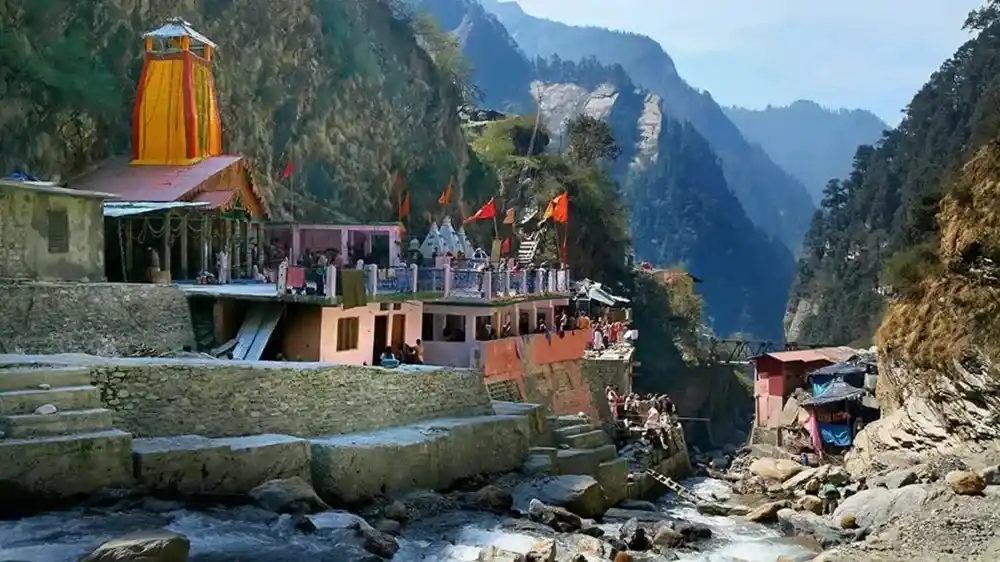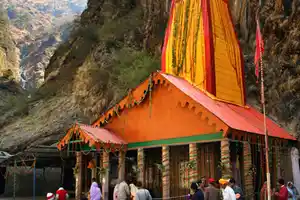Yamunotri Temple – Infortmation About Goddess Yamuna the Sister of Yamraj
Home » Yamunotri Dham »
Situated on the western of the Garhwal Himalayan ranges of Uttarkashi district, Yamunotri Dham sits at an altitude of 3,293 meters above sea level. It marks not only the origin of the holy River Yamuna but also the first stop of the Char Dham Yatra, a sacred journey in Hinduism. Dedicated to Goddess Yamuna, the temple holds immense spiritual significance as the goddess is believed to be the daughter of the Sun God (Surya) and the sister of Yama, the God of Death.

Religious Significance
Goddess Yamuna is deeply revered in Hindu mythology. People on a Char Dham Yatra pilgrimage start their journey from Yamunotri and then head on to their other destinations. Bathing in the Yamuna is believed to cleanse sins and bestow longevity. People visit this shrine to seek blessings of prosperous life and protection from untimely death, as the goddess is the sister of Yama or Yamraj, the god of death. The temple is known for its scenic beauty, unparalleled spiritual vibes, and breathtaking vistas which you must experience at least once in your lifetime.
The Legend of Sage Asit Muni
According to the legend, Sage Asit Muni made Yamunotri his hermitage. He used to take a bath in both the holy rivers of Ganga and Yamuna on a daily basis. However, as he grew older and unable to travel to Gangotri to bathe, a miraculous stream of the Ganga appeared near Yamunotri, so that the sage could continue his spiritual practices. The temple marks the presence of this great saint as well as a way to honor the presence of one of the most sacred rivers of India, Yamuna.
Origin of the River Yamuna:
The holy river of Yamuna originates from the Yamunotri glacier located at the height of 6,315 meters near the Kalind Parbat. The river first forms the Saptarishi Kund a high-altitude glacial lake, and then flows downward, creating a series of cascading waterfalls. Kalind Parbat is situated on the Bandarpoonch Parvat and is known for being the dominant peak in the central Himalayan region of Garhwal which divides the watershed of river Yamuna from that of River Ganga. Yamuna is also popularly known as Kalindi while it emerges from the Kalindi Parbat.
Mythology: Hanuman and the Bandarpoonch Connection
According to legend, it is a popular belief that after burning down the evil king Ravana’s island country of Lanka, Lord Hanuman paid a visit to the Bandarpoonch Parvat to cool his scorched tail in the icy water of the holy river of Yamuna. This legend explains why the peak is named so since Bandar means monkey and pooch means tail in Hindi.
Architecture of Yamunotri Temple
The original date of the temple’s construction is still unknown. However, the currently standing temple is believed to have been built during the 19th century in the Nagar architectural style. This construction was undertaken by the queen of Jaipur as a renovation project after a major part of the temple was destroyed due to some changes in the weather. Granite stones were used in the construction of this temple which was later on topped by a minaret that is conical in shape. The temple stands out among its lush greenery with its vibrant colors of bright yellow and red.
Inside the Temple:
- The idol of Goddess Yamuna is made of smooth black marble.
- A Garbha Griha (sanctum sanctorum) houses the idol.
- A Mandap (assembly hall) allows devotees to gather and offer prayers.
Sacred Hot Springs: Surya Kund & Gauri Kund
Two natural hot water springs lie just outside the temple:
- Surya Kund (named after the Sun God) is used by devotees to boil rice and potatoes in muslin cloths, which are later offered as Prasadam.
- Gauri Kund is used for bathing and is believed to have medicinal properties that relieve physical ailments.
After the trek to Yamunotri, these springs serve as a soothing rest point, which is about 6 km from the nearest road at Janki Chatti.
Tips for Visitors
- Best time to visit: May to October (the temple closes in winter)
- Accessibility: Reachable by road till Janki Chatti, followed by a 6 km trek
- Things to Carry: Warm clothes, rain gear, walking stick, and basic medical supplies
Yamunotri is not just a holy site but also a perfect blend of natural beauty, spiritual tranquility, and mythological significance. Whether you are looking for spiritual enlightenment or want to experience nature at its best, Yamunotri is indeed an unforgettable destination that soothes your soul.


Leave a Reply